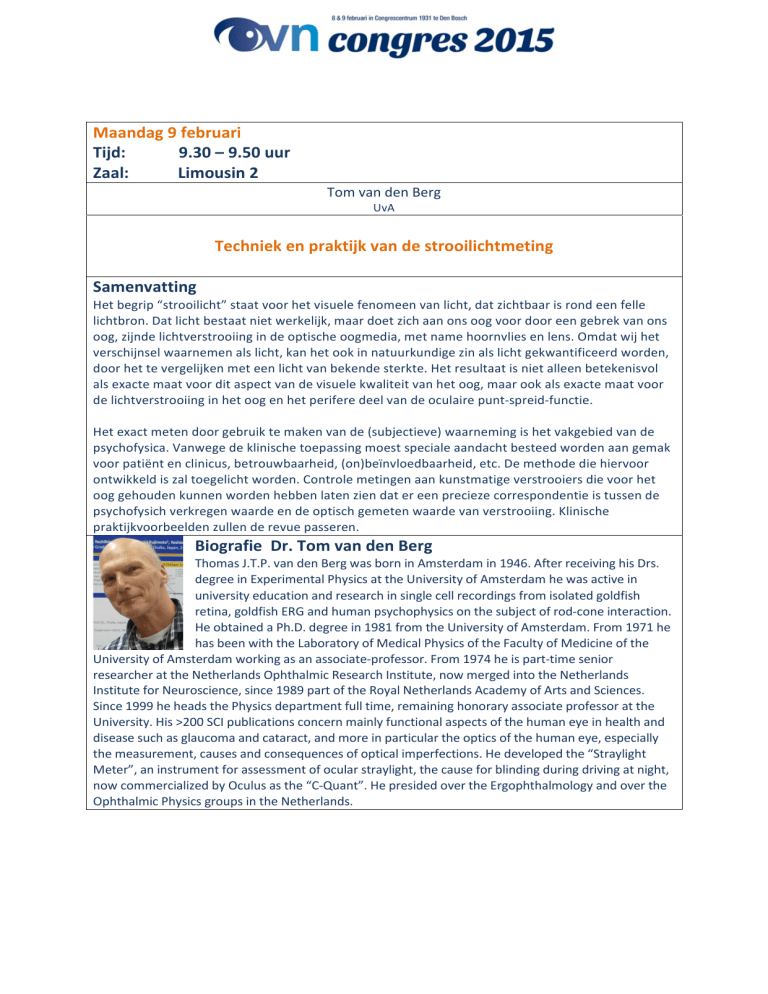
Maandag 9 februari Tijd: 9.30 – 9.50 uur Zaal: Limousin 2 Tom van den Berg UvA Techniek en praktijk van de strooilichtmeting Samenvatting Het begrip “strooilicht” staat voor het visuele fenomeen van licht, dat zichtbaar is rond een felle lichtbron. Dat licht bestaat niet werkelijk, maar doet zich aan ons oog voor door een gebrek van ons oog, zijnde lichtverstrooiing in de optische oogmedia, met name hoornvlies en lens. Omdat wij het verschijnsel waarnemen als licht, kan het ook in natuurkundige zin als licht gekwantificeerd worden, door het te vergelijken met een licht van bekende sterkte. Het resultaat is niet alleen betekenisvol als exacte maat voor dit aspect van de visuele kwaliteit van het oog, maar ook als exacte maat voor de lichtverstrooiing in het oog en het perifere deel van de oculaire punt-­‐spreid-­‐functie. Het exact meten door gebruik te maken van de (subjectieve) waarneming is het vakgebied van de psychofysica. Vanwege de klinische toepassing moest speciale aandacht besteed worden aan gemak voor patiënt en clinicus, betrouwbaarheid, (on)beïnvloedbaarheid, etc. De methode die hiervoor ontwikkeld is zal toegelicht worden. Controle metingen aan kunstmatige verstrooiers die voor het oog gehouden kunnen worden hebben laten zien dat er een precieze correspondentie is tussen de psychofysich verkregen waarde en de optisch gemeten waarde van verstrooiing. Klinische praktijkvoorbeelden zullen de revue passeren. Biografie Dr. Tom van den Berg Thomas J.T.P. van den Berg was born in Amsterdam in 1946. After receiving his Drs. degree in Experimental Physics at the University of Amsterdam he was active in university education and research in single cell recordings from isolated goldfish retina, goldfish ERG and human psychophysics on the subject of rod-­‐cone interaction. He obtained a Ph.D. degree in 1981 from the University of Amsterdam. From 1971 he has been with the Laboratory of Medical Physics of the Faculty of Medicine of the University of Amsterdam working as an associate-­‐professor. From 1974 he is part-­‐time senior researcher at the Netherlands Ophthalmic Research Institute, now merged into the Netherlands Institute for Neuroscience, since 1989 part of the Royal Netherlands Academy of Arts and Sciences. Since 1999 he heads the Physics department full time, remaining honorary associate professor at the University. His >200 SCI publications concern mainly functional aspects of the human eye in health and disease such as glaucoma and cataract, and more in particular the optics of the human eye, especially the measurement, causes and consequences of optical imperfections. He developed the “Straylight Meter”, an instrument for assessment of ocular straylight, the cause for blinding during driving at night, now commercialized by Oculus as the “C-­‐Quant”. He presided over the Ergophthalmology and over the Ophthalmic Physics groups in the Netherlands.












